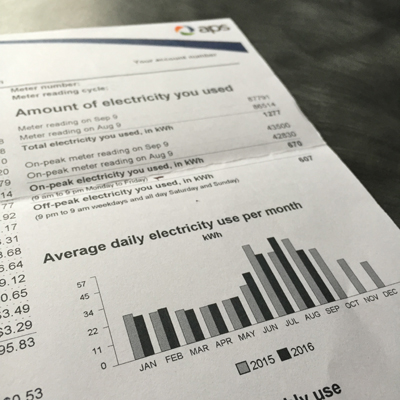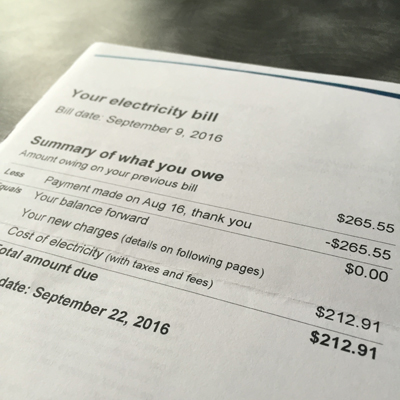Six Steps to Big Savings on Your Electric Bill
 20 September 2016
20 September 2016 

Over the past couple of years, hundreds if not thousands of Arizona residents have learned from “Rosie on the House” about how to super-cool their homes during summer in order to cut the size of electric bills.
Now we’ll let you in on five concepts to keep in mind about your monthly utility bill that might help cut your electric bills all year round, whether you’re super-cooling your house or not. If possible, get out your last bill for reference.
Most of you will be looking at a bill from Arizona Public Service, which serves about 75 percent of the customers in the state. But many other electric customers buy power from Salt River Project and from Tucson Electric Power. Several smaller companies serve the rest of the power customers.
1 | Forget about the fees and taxes.

On the left side of your APS bill, you’ll find nearly 20 separate fees or taxes listed first of all. But they’re a distraction that you should ignore. They are all part of what you pay for your electricity and they always have been. No sense getting mad about those charges. You want to take action instead. (For more info on what those charges are all about, check out the definitions below.)
2 | Find out your cost per kWh.
Take the “total charges for electricity services” listed on that bill and divide by the total kilowatt hours that your home used; your kWh number is usually in the upper right corner. That calculation will give you what you pay on average per kilowatt hour for electricity. (SRP or TEP customers can do the same with charges on their bills.) If you’re paying 12 to 14 cents a kWh, you’re doing an average job and doing fairly well at controlling your bill. If you’re running 10 cents per kWh or less, you’re doing a great job. But if you have a cost of 15 to 16 cents per kWh – you’re doing a bad job of controlling costs and probably have high bills.
3 | Get rid of your standard rate plan.
If you have a costly bill, you’re probably on the utility’s standard rate plan which means that you pay a high kWh price every hour of the day. Many customers accidentally get on these plans when they first call up the utility to start service. These plans charge the same average rate every hour of the day and they really only work for a single person living in a home or apartment with 1,000 square feet of space or less.
4 | Get on a time-of-use plan.

A high cost of kWh number often means you’re probably not on a cost-saving, time-of-use rate plan. So call up your utility and ask to get on one as soon as possible. Among the better plans are the SRP rate plan that in summer charges higher rates from 1 to 8 p.m. on weekdays and the APS plan that charges higher rates from noon to 7 p.m. all year long. (With SRP, winter hours differ.) The aim is to use electricity more during hours when rates are low. Keep the AC on more during the weekends. Do your wash and bake your cakes in the mornings or after 7 p.m. when rates are less. “I haven’t heard from a customer yet whose bills didn’t go down once they switched to a time of use plan,” says Steve Koepp of Advanced Home Systems in Phoenix, a company that helps homeowners control utility costs. Koepp gave us much of the information for this column.
5 | Keep up the research.
After you change plans, SRP bills will show you what you are paying in on-peak vs. off-peak periods. Your APS bill will not. However, what both bills will show is how many kWh you have used on- and off-peak. On-peak should only be 20 to 25 percent of your bill. You are really doing well if it’s 12 to 15 percent for on-peak use for either utility. With all utilities, you should keep dividing total charges by total kWhs.
6 | Get off budgeting equalizer plans.
These plans charge you the same amount every month for power rather than sending bigger bills during the hot season and smaller bills in cooler months. This process takes some of the pain out of bills in summer when your AC drives up your costs. But they can be a poor solution because you tend to waste energy if you think your bill will never change. In addition, if your power use increases one year, the next year that average monthly bill will be bigger than last year.
Another problem: If a defective appliance starts using power excessively, like a pool pump, for example, you might not notice the problem for months when you’re on an equalizer plan.
And of course, equalizer plans make it harder for you to keep track of what you’re spending per kWh.
What are those charges for electric services on your APS bill?
Here are some of the most puzzling charges and what they pay for:
Environmental benefits surcharge – Pays for programs approved by the Arizona Corporation Commission, including energy efficiency and renewable energy projects.
Federal environmental improvement surcharge – Pays for environmental improvements at the APS facilities that were federally mandated.
System benefits charge – Pays for assistance for low-income users, customer education, environmental programs, long term public benefit research, nuclear fuel disposal and nuclear power plant decommissioning and other programs.
Franchise fee – Fee charged by a city or county for APS using of public rights-of-way.
Power supply adjustment – Passes on rapid changes in fuel and other power costs to you the consumer.
Regulatory assessment – Helps fund the Arizona Corporation Commission and Residential Utility Consumer’s Office.
Federal transmission and ancillary services – Pays for moving high voltage electricity from generating facilities to APS.
Federal transmission cost adjustment – This charge adjusts for annual changes in transmission costs to serve customers. It’s based on your use of kWhs.
Four Corners adjustment – APS has bought Four Corners Units 4 and 5, part of a power plant near Farmington, N.M., that previously belonged to Southern California Edison. This fee helps pay for that.
LFCR or Lost Fixed Cost Recover adjuster – This fee is the result of a 2012 settlement of a rate case that was approved by the Arizona Corporation Commission. It helps fund operation of the electric grid while allowing customers to use that grid as needed.
###
Photo Credits: Rosie on the House
RELATED CONTENT:
- DIY Q&A: How to super-cool your home - and save a ton of money!
- Blog: What is a mini-split AC system -- and what are the benefits?
- DIY Q&A: Consumer Guide: How to Buy and AC System
- DIY Q&A: What you need to know about home insurance.
- Find trusted Arizona contractor and home improvement service providers
Print this page
recent post
- Duck, Duck, Duct! How Often Should Ductwork Be Cleaned?
- Vinyl vs. Fiberglass Windows: Which Is The Better Choice Of Replacement Window?
- We May Be The Grand Canyon State, But The Rocky Mountains Are Important For Arizona
- Welcome to Arizona! Things A Newbie to Arizona Should Know
- The Pros & Cons of Buying A Flipped House
- Getting In On The Ground Floor
- Why It’s More Critical Than Ever To Get Your AC Serviced Before Summer
- The Reality of Remodeling
- What To Look For When Comparing Your Roofing Quotes
- What To Expect When Buying New Windows & Doors
